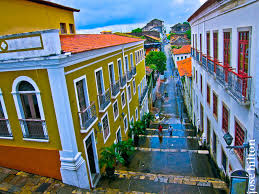Showing posts with label Brazil - Historic Centre of the Town of Olinda. Show all posts
Showing posts with label Brazil - Historic Centre of the Town of Olinda. Show all posts
Thursday, 12 May 2022
BRAZIL
This cover from Brazil depicts 2 different stamps, including a stamp issued in 1999 celebrating the Historic Centre of the Town of Olinda. Olinda is a historic city in Pernambuco, Brazil, in the Northeast Region. It is located on the country's northeastern Atlantic Ocean coast, in the Metropolitan Region of Recife, the state capital.The town of Olinda has been inhabited since 1535. As the former capital of the Captaincy of Pernambuco during the colonial era, Olinda has many historical buildings. The centre was declared a UNESCO World Heritage Site in 1982. The Carnaval of Olinda, a popular street party, is very similar to traditional Portuguese carnivals, with the addition of African influenced dances, reflecting the history of the Northeast. All the festivities are celebrated on the streets with no bleachers or roping, and unlike in other cities, admission is free. There are hundreds of small musical groups (sometimes featuring a single performer) in many genres.
Tuesday, 6 June 2017
BRAZIL
Thanks to my friend Luciano Ferrari I got this amazing UNESCO cover from Brazil, depicting a miniature sheet with 3 different Unesco sites in Brazil: Ouro Preto, Olinda and São Luís:
Historic Town of Ouro Preto (since 1980) - founded at the end of 17th century, Ouro Preto (Black Gold), was the local point of the gold rush and Brazil's golden age in the 18th century. With the exhaustion of the gold mines in the 19th century, the city's influence declined but many churches, bridges and fountains remains as a testimony to its past prosperty.


Historic Centre of the Town of Olinda (since 1982) - founded in the 16th century by the Portuguese, the town's history is linked in the sugar-cane industry. Rebuilt after being looted by the Dutch, its basis urban fabric dates from the 18th century. The harmonious balance between the buildings, gardens, 20 baroque churches, convents and numerous small passos (chapels) all contribute to Olinda's particular charm.


Historic Centre os São Luís (since 1982) - the late 17th-century core of this historic town, founded by the French and occupied by the Dutch before coming under Portuguese rule, has preserved the original rectangular street plan in its entirety. Thanks to a period of economic stagnation in the early 20th century, an excepcional number of fine historic buildings have survived, making this an outstanding example of an iberian colonial town.


Historic Town of Ouro Preto (since 1980) - founded at the end of 17th century, Ouro Preto (Black Gold), was the local point of the gold rush and Brazil's golden age in the 18th century. With the exhaustion of the gold mines in the 19th century, the city's influence declined but many churches, bridges and fountains remains as a testimony to its past prosperty.
Historic Centre of the Town of Olinda (since 1982) - founded in the 16th century by the Portuguese, the town's history is linked in the sugar-cane industry. Rebuilt after being looted by the Dutch, its basis urban fabric dates from the 18th century. The harmonious balance between the buildings, gardens, 20 baroque churches, convents and numerous small passos (chapels) all contribute to Olinda's particular charm.
Historic Centre os São Luís (since 1982) - the late 17th-century core of this historic town, founded by the French and occupied by the Dutch before coming under Portuguese rule, has preserved the original rectangular street plan in its entirety. Thanks to a period of economic stagnation in the early 20th century, an excepcional number of fine historic buildings have survived, making this an outstanding example of an iberian colonial town.
Subscribe to:
Posts (Atom)

